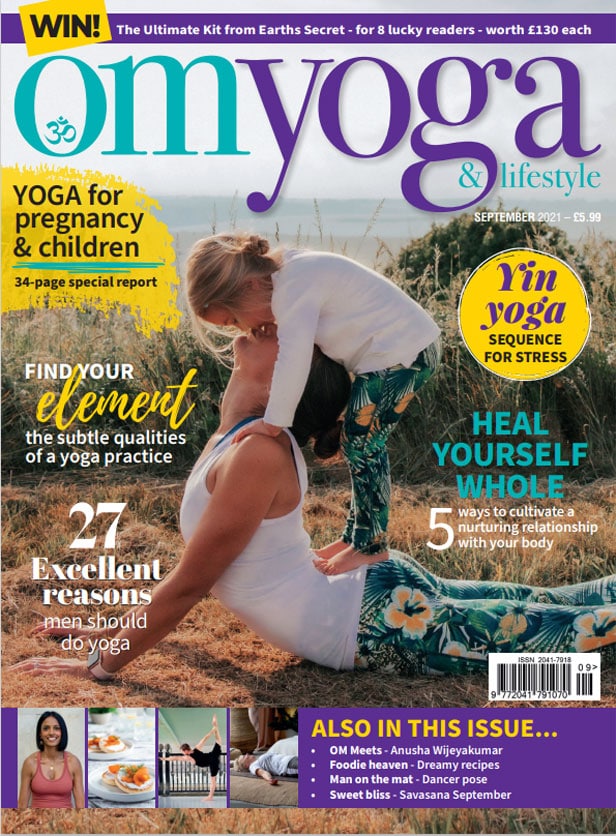
Heal yourself whole
5 tips to cultivate a meaningful, empowered and nurturing relationship with your body. By Emily A. Francis
The body is full of magic and wisdom. I say this often hoping to remind people that within your body is an entire symphony of brilliance that has nothing to do with the physical form. As a clinical and neuromuscular massage therapist, lymphedema therapist, and reiki master, and former yoga instructor, I see the body in a very specific way. I have been privileged to witness incredible healing miracles that were born from the same place within the body where the original traumas or poisonous roots were planted.
1. The first being in any given situation for healing, the unlock button begins with giving yourself permission to heal whatever is out of balance. This may sound simple, but it is much more difficult than the way it sounds in a statement. Giving yourself permission to heal asks that you will be willing to remove the guilt and shame patterns that line up too many times around causation of why something poisonous has planted within the system in the first place. To give yourself permission to heal means that you are willing to accept whatever situations as they occurred, no longer taking blame, guilt, or shame into it and realising that you deserve to heal, recover, balance and experience freedom from a deeper space. This is an act of courage to relieve yourself from the repeat patterns that hammer down dark roots that have been spreading itself around your system. I love yogis. People who practice yoga as a way of life tend to understand healing and acceptance practices in a deeper and more full-scale way. The approach into personal health and vitality is more of a whole being approach. That does not mean that because you do all you can to live from a clean space of mind and body that we are not still prone to guilt and shame patterns or that we do not still hold traumas or grief. It means we are all human but do all we can to create our behaviours from the highest and most present space we can.
2. Tip number two: you are still human, accept it and work within those confines without putting too much pressure to become anything more than exactly who you are. We are all familiar with the ideas of karma. We used to practice karma yoga at the ashram. My karma yoga was cleaning the bathrooms each day. The thing I loved about our karma yoga work was that no one was allowed to criticise or compliment anyone else’s work. Each person had their own assignment, and no human had any part of your experience. It was up to you to do your best work to burn away old karmas that you had incurred as well as to do work for Great Spirit, not other people. It was a higher calling and it taught us the value of hard work without looking for external praise or approval. That was a simple yet powerful lesson to do work and know that no outside responses will be offered. Karma plays a great role in these action and acceptance behaviours to release and remove them from within.
3. Tip number three: Awareness of how everything you think, feel and act on affects all areas of your life is the beginning of the path to purify. There are three types of karma according to yoga philosophy: sanchita, prarabdha, and agami. When I went through my yoga teacher training, they used this image to explain the three. A person with a sack on his back containing a bow and arrows. The person reaches into the bag and grabs the bow, sanchita. This requires thoughts of wanting to do a particular action. It’s the intention that begins the whole thing. It is the karma that has not been set out into the world yet but the thoughts and plans of action have begun to rise. It has not yet landed but the intention is there. Then the person loads the bow and pulls it back ready to release it, prarabdha, this is the action itself. Finally, the bow is released into the air about to land, agami, the future consequence of the action.

If we were to take these concepts and apply them to our own healing process, sanchita would be setting the intention to heal the parts of ourselves that are out of balance. It would be figuring out what those are, where they come from and begin the research to gather information to help our cause. Next, we would start to put what we are learning into action, prarabdha karma. We are now beginning to do the work that our bodies are asking us to do in order to apply the knowledge gained to help ourselves rearrange the way that our memories and dialogue that has been sitting within the tissues have been stored. Finally, the results from the gathering and the action of what we have learned and are currently applying for ourselves results in agami karma. That comes later. We won’t see the exact fruits of our actions immediately. It takes time to change the way that we treat ourselves on a deep level. The yogis and sages understood this concept better than anybody. It takes time for our actions to make it to the victories of our fruits and labours.
4. My fourth tip for cultivating a loving relationship within is that it is perfectly okay not to be okay all the time. You are allowed to feel all of your feelings and sit with them as they arise. This also includes feeling the feelings of bliss, of joy, of laughter, of happiness. This can sometimes be even more of a bold move than sitting with your feelings of guilt, of shame, of pain, or of grief. We are so quick to pair feeling pure bliss with a fear of impending doom that lingers just around the corner. But what if you just let yourself feel the bliss sensations as they come and go into your space and not follow it up with any sort of negative self-talk or fear? What if you took your practice to a level that had nothing at all to do with the physical asana practice but instead allowed yourself to burn some of the karma from your life and allowed yourself to feel the freedoms that come with being present to joy when it pays you a visit?
5. This leads me to my fifth tip for cultivating a more nurturing space for ourselves. Be gentle with yourself. It takes time to make changes that last. Give yourself the space and support to make whatever changes that your body is asking that you shift. This does not mean change your diet or add more practice time. I’m not talking about anything physical. The physical changes are part of the agami karma. They are the results of the efforts you have put in to your healing and acceptance of self.
My bonus tip is an all-encompassing tip. When I was a massage student, we were reminded time and again that “healthy tissue doesn’t hurt.” When you make deep and lasting shifts from guilt, shame and self-defeat patterns and self-talk, the actual tissues of the body begin to shift and nourish. If you don’t think that the way you speak to yourself matters, take a trip with your hands down different bodies of people who do not forgive themselves for any number of things versus someone who has done tremendous inner release work and you will find a night and day difference within the tissues themselves. A person who eats clean, practices having positive, realistic and loving thoughts for themselves and others, who feels their feelings when they come up, who does not push back experiences of heavy emotions and blissful spaces has a completely different constitution within their skin tissues. Those changes manifest themselves from a deep-planted seed into the soft tissues of the body and work their effects all the way up to skin level. It is incredible and palpable! This is where freedom into self-healing can grow and flourish.
Lastly, you deserve to feel freedom and balanced health and wellbeing within your entire being. Give yourself permission to accept this truth and watch how permission to heal becomes possible. It’s right there inside you waiting for you to agree and move from that space.
Emily A. Francis is a highly sought-after speaker, wellness expert and author of Healing Ourselves Whole: An Interactive Guide to Release Pain and Trauma by Utilising the Wisdom of the Body. Visit: emilyafrancisbooks.com





